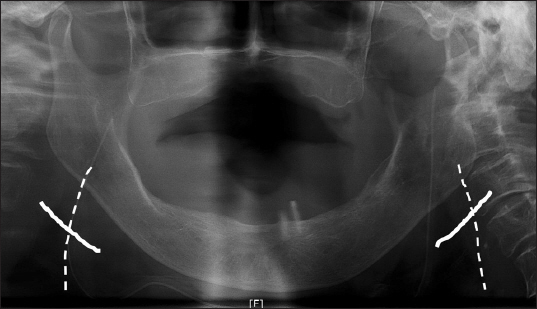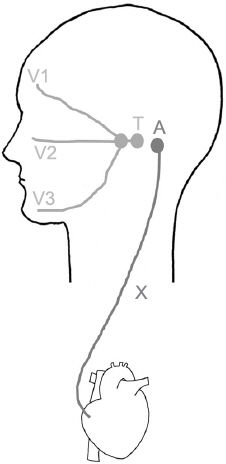Anesth Pain Med.
2019 Jul;14(3):255-258. 10.17085/apm.2019.14.3.255.
Trigeminocardiac reflex: sudden severe bradycardia during open reduction for temporomandibular joint dislocation: A case report
- Affiliations
-
- 1Department of Anesthesiology and Pain Medicine, Chungnam National University College of Medicine, Daejeon, Korea. ane84@cnuh.co.kr
- KMID: 2454808
- DOI: http://doi.org/10.17085/apm.2019.14.3.255
Abstract
- BACKGROUND
The trigeminocardiac reflex (TCR), which occurs after stimulation of the territory of the trigeminal nerve, is very rarely reported to be caused by stimulation of the mandibular branch. We report a case of TCR in open reduction for temporomandibular joint (TMJ) dislocation. CASE: A 74-year-old female presented for TMJ dislocation. During open reduction of TMJ under general anesthesia, severe bradycardia (15 beats/min) occurred. Immediately 0.5 mg atropine was administered intravenously, and the surgical manipulation was stopped. After 30 seconds, heart rate normalized. During surgery, severe bradycardia occurred one more time. It disappeared spontaneously as soon as surgical manipulation was stopped. The surgery was completed uneventfully.
CONCLUSIONS
Because of the possibility of profound bradycardia, asystole, or even death when evoked, it is important to be aware of the trigeminocardiac reflex during manipulation of the mandibular divisions, especially during surgical stimulation of the TMJ.
Keyword
MeSH Terms
Figure
Reference
-
1. Joshi UM, Munnangi A, Shah K, Patil SG, Thakur N. Trigemino-cardiac reflex:a phenomenon neglected in maxillofacial surgery? J Maxillofac Oral Surg. 2017; 16:181–5. DOI: 10.1007/s12663-016-0959-6. PMID: 28439158. PMCID: PMC5385689.2. Choi SR, Park SW, Lee JH, Lee SC, Chung CJ. Effect of different anesthetic agents on oculocardiac reflex in pediatric strabismus surgery. J Anesth. 2009; 23:489–93. DOI: 10.1007/s00540-009-0801-0. PMID: 19921355.3. Chowdhury T, Mendelowith D, Golanov E, Spiriev T, Arasho B, Sandu N, et al. Trigeminocardiac reflex:the current clinical and physiological knowledge. J Neurosurg Anesthesiol. 2015; 27:136–47. DOI: 10.1097/ANA.0000000000000065. PMID: 25602626.4. Tarabanis C, Abt NB, Osborn HA. Intraoperative cardiac arrest etiologies in head and neck surgery:a comprehensive review. Head Neck. 2018; 40:1299–304. DOI: 10.1002/hed.25090. PMID: 29385305.5. Lang S, Lanigan DT, van der Wal M. Trigeminocardiac reflexes:maxillary and mandibular variants of the oculocardiac reflex. Can J Anaesth. 1991; 38:757–60. DOI: 10.1007/BF03008454. PMID: 1914059.6. Lübbers HT, Zweifel D, Grätz KW, Kruse A. Classification of potential risk factors for trigeminocardiac reflex in craniomaxillofacial surgery. J Oral Maxillofac Surg. 2010; 68:1317–21. DOI: 10.1016/j.joms.2009.12.039. PMID: 20347202.7. Holmes WD, Finch JJ, Snell D, Sloan SB. The trigeminocardiac reflex and dermatologic surgery. Dermatol Surg. 2011; 37:1795–7. DOI: 10.1111/j.1524-4725.2011.02159.x. PMID: 22092884.8. Ivošević T, Miličić B, Dimitrijević M, Ivanović B, Pavlović A, Stojanović M, et al. Risk factors for intraoperative bradycardia during ear, nose, throat and maxillofacial surgery. Eur Arch Otorhinolaryngol. 2018; 275:579–86. DOI: 10.1007/s00405-017-4837-8. PMID: 29214434.9. Shelly MP, Church JJ. Bradycardia and facial surgery. Anaesthesia. 1988; 43:422. DOI: 10.1111/j.1365-2044.1988.tb09042.x.10. Meuwly C, Chowdhury T, Gelpi R, Erne P, Rosemann T, Schaller B. The clinical surrogate definition of the trigeminocardiac reflex:development of an optimized model according to a PRISMA-compliant systematic review. Medicine (Baltimore). 2017; 96:e9033. DOI: 10.1097/MD.0000000000009033. PMID: 29245296. PMCID: PMC5728911.11. Campbell R, Rodrigo D, Cheung L. Asystole and bradycardia during maxillofacial surgery. Anesth Prog. 1994; 41:13–6. PMID: 8629742. PMCID: PMC2148710.12. Lee SY, Chun DH, Lee T, Kim MY, Park SY. Asystole during microvascular decompression in case of trigeminal neuralgia:a case report. Anesth Pain Med. 2014; 9:58–60.
- Full Text Links
- Actions
-
Cited
- CITED
-
- Close
- Share
- Similar articles
-
- Asystole via Trigeminocardiac Reflex during Skin Flap Elevation in a Patient Undergoing Craniotomy for Cerebral Aneurysm Clipping: A case report
- New Mechanism of Vasovagal Syncope: Trigeminocardiac Reflex
- Profound trigeminocardiac reflex from lingual nerve stimulation: a case report
- Manual Reduction of Temporomandibular Joint Long-standing Dislocation under General Anesthesia
- Open and Closed Reduction of Temporomandibular Joint Dislocation due to Tongue Cancer Operation



